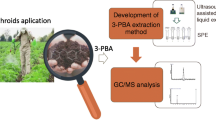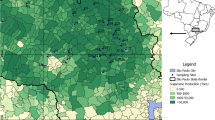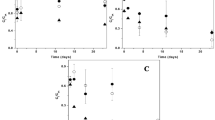Abstract
The growing use of reclaimed water in agriculture worldwide calls for developing high-sensitivity methods to quantify wastewater-derived organic contaminants in soils so that the potential risk of this irrigation practice can be properly assessed. This work describes an analytical method for the determination of trace levels of 14 drugs that are known to be poorly removed during conventional wastewater treatment in soil. The analytes selected for investigation included ten pharmaceuticals from different therapeutic classes (carbamazepine, diclofenac, cis-diltiazem, lamotrigine, methadone, midazolam, oxcarbazepine, sulfamethoxazole, trimethoprim, valsartan), one illicit drug (cocaine), and three transformation products/metabolites (acridone, 4′-hydroxydiclofenac, and valsartan acid), thereby covering a broad range of physical–chemical properties. The methodology developed was based on ultrasonic solvent extraction (USE) of the analytes from the soil matrix, and subsequent clean-up and analysis of the USE extracts with a fully automated approach by means of solid-phase extraction and liquid chromatography-tandem mass spectrometry detection (online SPE-LC-MS/MS). The method was fully validated with affording method detection and quantification limits ranging from 0.03 to 1 ng g−1 and from 0.09 to 3.3 ng g−1, respectively. This method was applied to investigate the fate of the selected drugs in potting soil irrigated for a long term (60 days) either with water containing the target compounds at a concentration of 200 μg L−1 or with wastewater treatment plant effluent and thus, at real environmental concentrations. All investigated compounds were found to accumulate in soil irrigated with artificially fortified water. The highest accumulation potential was observed for cis-diltiazem followed by methadone and midazolam that presented average concentrations of 1517 ng g−1, 1041 ng g−1, and 962 ng g−1 d.w., respectively. On the contrary, oxcarbazepine (5.8 ng g−1) and sulfamethoxazole (22 ng g−1) were the target drugs presenting the lowest accumulation potential. Only trace levels of ten drugs were measured in soil irrigated with regenerated water (average concentrations between 1.6 and 4.7 ng g−1 d.w.).

Graphical abstract




Similar content being viewed by others
References
Vodyanitskii YN, Yakovlev A. Contamination of soils and groundwater with new organic micropollutants: a review. Eurasian Soil Sci. 2016;49(5):560–9.
Ferhi S, Bourdat-Deschamps M, Daudin J-J, Houot S, Nélieu S. Factors influencing the extraction of pharmaceuticals from sewage sludge and soil: an experimental design approach. Anal Bioanal Chem. 2016;408(22):6153–68.
Petrie B, Barden R, Kasprzyk-Hordern B. A review on emerging contaminants in wastewaters and the environment: current knowledge, understudied areas and recommendations for future monitoring. Water Res. 2015;72:3–27.
Carter LJ, Garman CD, Ryan J, Dowle A, Bergström E, Thomas-Oates J, et al. Fate and uptake of pharmaceuticals in soil–earthworm systems. Environ Sci Technol. 2014;48(10):5955–63.
Li WC. Occurrence, sources, and fate of pharmaceuticals in aquatic environment and soil. Environ Pollut. 2014;187:193–201.
Monteiro SC, Boxall AB. Occurrence and fate of human pharmaceuticals in the environment. Rev Environ Contam Toxicol. Springer; 2010. p. 53–154.
Zhao L, Dong YH, Wang H. Residues of veterinary antibiotics in manures from feedlot livestock in eight provinces of China. Sci Total Environ. 2010;408(5):1069–75.
Durán-Alvarez JC, Becerril-Bravo E, Castro VS, Jiménez B, Gibson R. The analysis of a group of acidic pharmaceuticals, carbamazepine, and potential endocrine disrupting compounds in wastewater irrigated soils by gas chromatography–mass spectrometry. Talanta. 2009;78(3):1159–66.
Kümmerer K. The presence of pharmaceuticals in the environment due to human use–present knowledge and future challenges. J Environ Manag. 2009;90(8):2354–66.
Redshaw CH, Cooke MP, Talbot HM, McGrath S, Rowland SJ. Low biodegradability of fluoxetine HCl, diazepam and their human metabolites in sewage sludge-amended soil. J Soils Sediments. 2008;8(4):217.
Aga DS. Fate of pharmaceuticals in the environment and in water treatment systems. CRC Press; 2007.
Kinney CA, Furlong ET, Zaugg SD, Burkhardt MR, Werner SL, Cahill JD, et al. Survey of organic wastewater contaminants in biosolids destined for land application. Environ Sci Technol. 2006;40(23):7207–15.
Jjemba PK. Excretion and ecotoxicity of pharmaceutical and personal care products in the environment. Ecotoxicol Environ Saf. 2006;63(1):113–30.
Boxall AB, Sinclair CJ, Fenner K, Kolpin D, Maund SJ. Peer reviewed: when synthetic chemicals degrade in the environment. ACS Publications; 2004.
Kuster M, de Alda MJL, Barcelo D. Analysis and distribution of estrogens and progestogens in sewage sludge, soils and sediments. TrAC Trends Anal Chem. 2004;23(10–11):790–8.
Golet EM, Xifra I, Siegrist H, Alder AC, Giger W. Environmental exposure assessment of fluoroquinolone antibacterial agents from sewage to soil. Environ Sci Technol. 2003;37(15):3243–9.
Kumar K, Gupta SC, Chander Y, Singh AK. Antibiotic use in agriculture and its impact on the terrestrial environment. Adv Agron. 2005;87:1–54.
Sallach JB, Zhang Y, Hodges L, Snow D, Li X, Bartelt-Hunt S. Concomitant uptake of antimicrobials and Salmonella in soil and into lettuce following wastewater irrigation. Environ Pollut. 2015;197:269–77.
Resistance WA. Fact sheet N 194. Updated April. 2015.
Meyer E, Gastmeier P, Deja M, Schwab F. Antibiotic consumption and resistance: data from Europe and Germany. Int J Med Microbiol. 2013;303(6–7):388–95.
Montemurro N, Postigo C, Lonigro A, Perez S, Barceló D. Development and validation of an analytical method based on liquid chromatography–tandem mass spectrometry detection for the simultaneous determination of 13 relevant wastewater-derived contaminants in lettuce. Anal Bioanal Chem. 2017;409(23):5375–87.
Prosser R, Sibley P. Human health risk assessment of pharmaceuticals and personal care products in plant tissue due to biosolids and manure amendments, and wastewater irrigation. Environ Int. 2015;75:223–33.
Carter LJ, Harris E, Williams M, Ryan JJ, Kookana RS, Boxall AB. Fate and uptake of pharmaceuticals in soil–plant systems. J Agric Food Chem. 2014;62(4):816–25.
Wu C, Spongberg AL, Witter JD, Sridhar BM. Transfer of wastewater associated pharmaceuticals and personal care products to crop plants from biosolids treated soil. Ecotoxicol Environ Saf. 2012;85:104–9.
Shenker M, Harush D, Ben-Ari J, Chefetz B. Uptake of carbamazepine by cucumber plants–a case study related to irrigation with reclaimed wastewater. Chemosphere. 2011;82(6):905–10.
Dolliver H, Kumar K, Gupta S. Sulfamethazine uptake by plants from manure-amended soil. J Environ Qual. 2007;36(4):1224–30.
Boxall AB, Johnson P, Smith EJ, Sinclair CJ, Stutt E, Levy LS. Uptake of veterinary medicines from soils into plants. J Agric Food Chem. 2006;54(6):2288–97.
Picó Y, Alvarez-Ruiz R, Alfarhan AH, El-Sheikh MA, Alobaid SM, Barceló D. Uptake and accumulation of emerging contaminants in soil and plant treated with wastewater under real-world environmental conditions in the Al Hayer area (Saudi Arabia). Sci Total Environ. 2019;652:562–72.
Łukaszewicz P, Białk-Bielińska A, Dołżonek J, Kumirska J, Caban M, Stepnowski P. A new approach for the extraction of tetracyclines from soil matrices: application of the microwave-extraction technique. Analy Bioanal Chem. 2018;1–11.
Azzouz A, Ballesteros E. Combined microwave-assisted extraction and continuous solid-phase extraction prior to gas chromatography–mass spectrometry determination of pharmaceuticals, personal care products and hormones in soils, sediments and sludge. Sci Total Environ. 2012;419:208–15.
Biel-Maeso M, Corada-Fernández C, Lara-Martín PA. Determining the distribution of pharmaceutically active compounds (PhACs) in soils and sediments by pressurized hot water extraction (PHWE). Chemosphere. 2017;185:1001–10.
Vazquez-Roig P, Segarra R, Blasco C, Andreu V, Picó Y. Determination of pharmaceuticals in soils and sediments by pressurized liquid extraction and liquid chromatography tandem mass spectrometry. J Chromatogr A. 2010;1217(16):2471–83.
Barron L, Tobin J, Paull B. Multi-residue determination of pharmaceuticals in sludge and sludge enriched soils using pressurized liquid extraction, solid phase extraction and liquid chromatography with tandem mass spectrometry. J Environ Monit. 2008;10(3):353–61.
Jelić A, Petrović M, Barceló D. Multi-residue method for trace level determination of pharmaceuticals in solid samples using pressurized liquid extraction followed by liquid chromatography/quadrupole-linear ion trap mass spectrometry. Talanta. 2009;80(1):363–71.
Bragança I, Plácido A, Paíga P, Domingues VF, Delerue-Matos C. QuEChERS: a new sample preparation approach for the determination of ibuprofen and its metabolites in soils. Sci Total Environ. 2012;433:281–9.
De Carlo RM, Rivoira L, Ciofi L, Ancillotti C, Checchini L, Del Bubba M, et al. Evaluation of different QuEChERS procedures for the recovery of selected drugs and herbicides from soil using LC coupled with UV and pulsed amperometry for their detection. Anal Bioanal Chem. 2015;407(4):1217–29.
Albero B, Sánchez-Brunete C, García-Valcárcel AI, Pérez RA, Tadeo JL. Ultrasound-assisted extraction of emerging contaminants from environmental samples. TrAC Trends Anal Chem. 2015;71:110–8.
Pico Y. Ultrasound-assisted extraction for food and environmental samples. TrAC Trends Anal Chem. 2013;43:84–99.
Hao C, Zhao X, Yang P. GC-MS and HPLC-MS analysis of bioactive pharmaceuticals and personal-care products in environmental matrices. TrAC Trends Anal Chem. 2007;26(6):569–80.
Nödler K, Hillebrand O, Idzik K, Strathmann M, Schiperski F, Zirlewagen J, et al. Occurrence and fate of the angiotensin II receptor antagonist transformation product valsartan acid in the water cycle–a comparative study with selected β-blockers and the persistent anthropogenic wastewater indicators carbamazepine and acesulfame. Water Res. 2013;47(17):6650–9.
Italian official methods of soil chemical analysis, Italian official methods of soil chemical analysis. Gazzetta Ufficiale della Repubblica Italiana SoN, 21/10/1999.
Matuszewski B, Constanzer M, Chavez-Eng C. Strategies for the assessment of matrix effect in quantitative bioanalytical methods based on HPLC−MS/MS. Anal Chem. 2003;75(13):3019–30.
Bruzzoniti MC, Checchini L, De Carlo RM, Orlandini S, Rivoira L, Del Bubba M. QuEChERS sample preparation for the determination of pesticides and other organic residues in environmental matrices: a critical review. Anal Bioanal Chem. 2014;406(17):4089–116.
Berlioz-Barbier A, Vauchez A, Wiest L, Baudot R, Vulliet E, Cren-Olivé C. Multi-residue analysis of emerging pollutants in sediment using QuEChERS-based extraction followed by LC-MS/MS analysis. Anal Bioanal Chem. 2014;406(4):1259–66.
Golovko O, Koba O, Kodesova R, Fedorova G, Kumar V, Grabic R. Development of fast and robust multiresidual LC-MS/MS method for determination of pharmaceuticals in soils. Environ Sci Pollut Res. 2016;23(14):14068–77.
Wu C, Spongberg AL, Witter JD, Fang M, Ames A, Czajkowski KP. Detection of pharmaceuticals and personal care products in agricultural soils receiving biosolids application. CLEAN–Soil, Air, Water. 2010;38(3):230–7.
Handreck KA, Black ND. Growing media for ornamental plants and turf. UNSW press; 2002.
Bunt B. Media and mixes for container-grown plants: a manual on the preparation and use of growing media for pot plants. Springer Science & Business Media; 2012.
Antignac J-P, Le Bizec B, Monteau F, Andre F. Validation of analytical methods based on mass spectrometric detection according to the “2002/657/EC” European decision: guideline and application. Anal Chim Acta. 2003;483(1–2):325–34.
Acknowledgments
The authors thank the Water Challenges for a Changing World Joint Programming Initiative, and the Spanish Ministry of Economy, Industry and Competitiveness (MINECO). The EU is not liable for any use that may be made of the information contained therein.
Funding
This study has been financially supported by the EU through the WaterJPI-2015 AWARE project (PCIN-2017-067) and the Generalitat de Catalunya (Consolidated Research Group “2017 SGR 01404 - Water and Soil Quality Unit”).
Author information
Authors and Affiliations
Corresponding author
Ethics declarations
Conflict of interest
The authors declare that there are no conflicts of interest.
Additional information
Publisher’s note
Springer Nature remains neutral with regard to jurisdictional claims in published maps and institutional affiliations.
Electronic supplementary material
ESM 1
(PDF 291 kb)
Rights and permissions
About this article
Cite this article
Montemurro, N., Postigo, C., Chirón, S. et al. Analysis and fate of 14 relevant wastewater-derived organic pollutants in long-term exposed soil. Anal Bioanal Chem 411, 2687–2696 (2019). https://doi.org/10.1007/s00216-019-01715-3
Received:
Revised:
Accepted:
Published:
Issue Date:
DOI: https://doi.org/10.1007/s00216-019-01715-3




